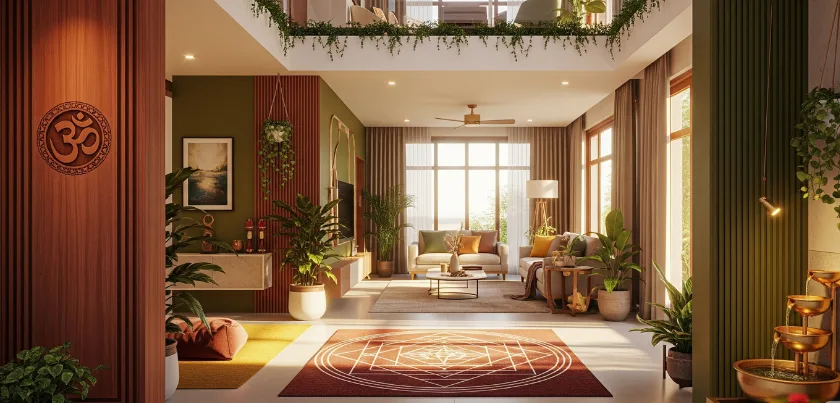How Vastu Shastra Influences Residential Architecture Design in India

When it comes to building a dream home in India, it’s not just about choosing the right tiles or paint colour; it’s also about creating a space that feels balanced, positive, and welcoming. This is where Vastu Shastra comes into play. For centuries, Vastu Shastra, the ancient Indian science of architecture, has shaped the way homes are designed. Even in today’s world of glass facades and smart home automation, Vastu continues to influence residential architecture design in India. It blends directional planning, energy flow, and the five elements of nature to ensure that your home is not just beautiful, but also in harmony with the universe. At Shree Constructions & Interior, we believe that a perfect home is one where modern design meets traditional wisdom. Let’s explore exactly how Vastu Shastra impacts the way Indian homes are planned and built.
Understanding the Basics of Vastu Shastra
Before diving into specifics, it’s important to know what Vastu is all about. The word Vastu means “dwelling” and Shastra means “science” — together, it’s the science of living spaces.
The principles of Vastu are based on aligning your home with nature’s five elements — Earth, Water, Fire, Air, and Space — and the cardinal directions. The idea is simple: when these elements are in balance, your home attracts positive energy, prosperity, and good health.
Home Orientation Matters
One of the first steps in Vastu-compliant residential architecture is deciding which way your home will face.
East-facing homes welcome the morning sunlight and are considered highly auspicious.
North-facing homes are linked to prosperity and financial growth.
South or West-facing homes can still be lucky, but they need specific design adjustments.
Architect’s Tip: If you’re buying land or planning a new home, consult a Vastu expert and your architect together — this ensures your home’s orientation is right from the start.
The Main Entrance is the Energy Gateway
- According to Vastu, the main door isn’t just an entry point — it’s the gateway for positive energy.
- Best directions: North, East, or North-East.
- Keep it well-lit, clean, and clutter-free.
- Avoid placing the entrance in the South-West corner unless there’s no alternative — in that case, certain remedies can be applied.
Room Placement for Balanced Living
Vastu suggests specific locations for different rooms to maximise harmony:
- Master bedroom: South-West for stability in life.
- Kitchen: South-East (Fire element) or North-West.
- Living room: North or East to encourage warmth and hospitality.
- Pooja room: North-East for spiritual growth.
This careful room arrangement ensures that every space supports your lifestyle and energy needs.
Balancing the Five Elements
Every Vastu-friendly home pays attention to balancing Earth, Water, Fire, Air, and Space:
- Use natural flooring for grounding.
- Place water features in the North-East for prosperity.
- Keep kitchens in the South-East for the Fire element.
- Plan ventilation and windows in the East and North for Air.
- Keep the central area of your home open to represent Space.
Letting in Natural Light & Air
One of the simplest Vastu principles is maximising natural light and ventilation.
- Large windows on the North and East sides welcome the morning sun.
- Skylights and courtyards bring in brightness and airflow.
- This not only improves energy flow but also reduces your electricity bills.
Colours That Boost Positive Energy
Colours can change the mood of your home:
- Light yellow or white: For North-East rooms to bring peace.
- Green: In the North for prosperity.
- Red or orange: In the South-East to enhance vitality.
Avoid using dark colours excessively in living spaces as they can absorb energy.
Furniture & Interior Layout
Even the way you arrange furniture matters in Vastu Shastra:
- Keep heavy furniture on the South or West sides of rooms.
- Beds should face East or South.
- Avoid blocking windows with bulky items.
Staircase Placement
For homes with multiple floors, Vastu recommends building staircases in the South-West, South, or West. Avoid placing them in the North-East as it can obstruct positive energy.
Vastu for Balconies & Outdoor Areas
Balconies, terraces, and open spaces are best placed in the North, East, or North-East. These areas should be open, uncluttered, and well-lit to encourage fresh energy.
Blending Vastu with Modern Architecture
You don’t have to choose between modern design and Vastu; you can have both.
At Shree Constructions & Interior, we use 3D architectural planning to merge Vastu guidelines with sleek, contemporary layouts. The result? A home that looks stunning, functions beautifully, and feels energetically balanced.
Why Vastu Still Matters Today
Even though modern architecture offers flexibility in design, Vastu adds an invisible layer of harmony. Many homeowners report feeling more peaceful, motivated, and secure in a Vastu-compliant home.
By considering these principles early in your residential architecture design, you save time, money, and effort later on.
Final Thoughts
Vastu Shastra is not about superstition; it’s about designing your home in a way that supports your health, relationships, and success. By aligning with nature’s energies, your home becomes more than just a shelter; it becomes a place that nurtures your life. If you’re building or renovating in Delhi NCR, let Shree Constructions & Interior create a Vastu-friendly home that’s modern, stylish, and full of positive energy.
